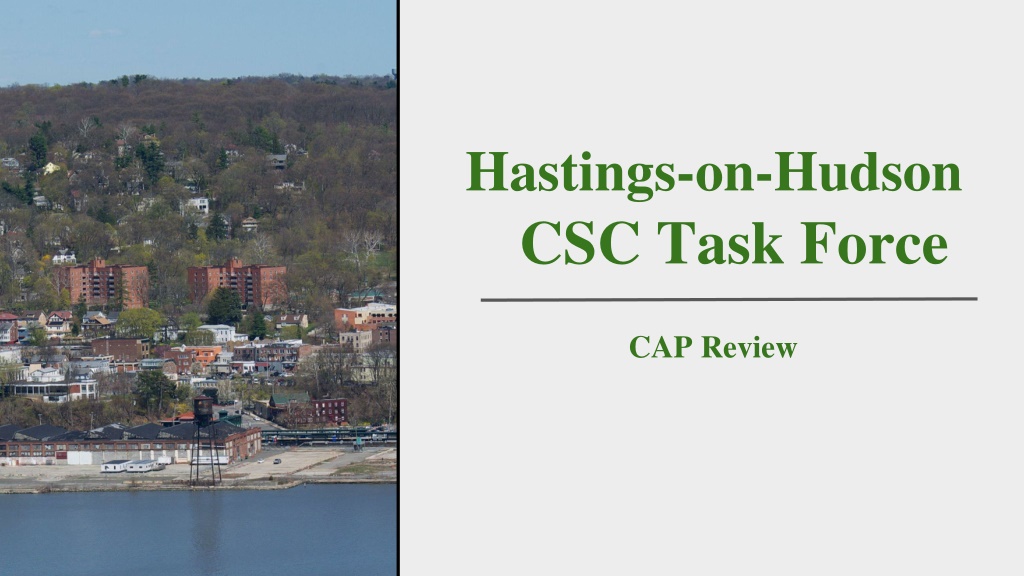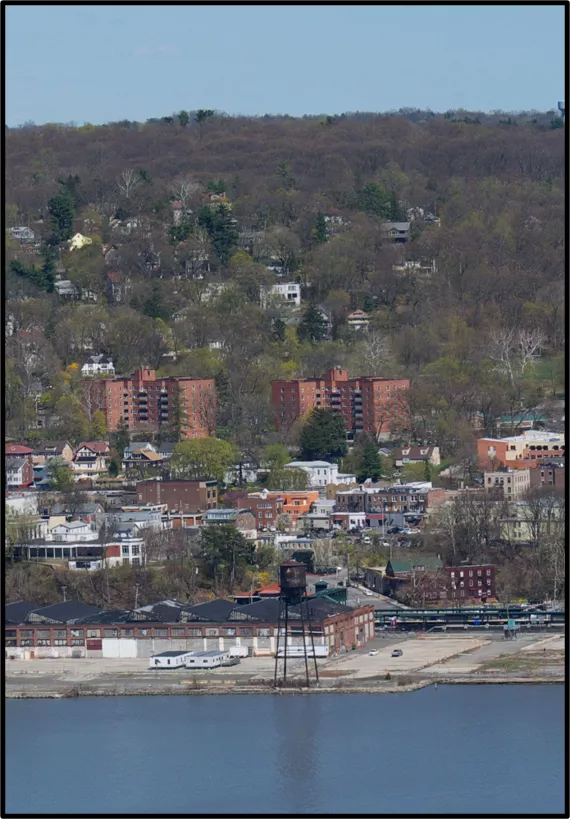Hastings-on-Hudson CSC Task Force CAP Review
The Hastings-on-Hudson CSC Task Force is conducting a Climate Action Plan (CAP) review process involving volunteer efforts, monthly meetings, and community engagement. The review includes developing objectives, validating key performance indicators (KPIs), and obtaining feedback from trustees and the community. The focus areas include transportation, adaptation, buildings, energy, waste, and water, with strategies aimed at reducing environmental impact and promoting sustainable practices.
Uploaded on Dec 08, 2024 | 0 Views
Download Presentation

Please find below an Image/Link to download the presentation.
The content on the website is provided AS IS for your information and personal use only. It may not be sold, licensed, or shared on other websites without obtaining consent from the author.If you encounter any issues during the download, it is possible that the publisher has removed the file from their server.
You are allowed to download the files provided on this website for personal or commercial use, subject to the condition that they are used lawfully. All files are the property of their respective owners.
The content on the website is provided AS IS for your information and personal use only. It may not be sold, licensed, or shared on other websites without obtaining consent from the author.
E N D
Presentation Transcript
Hastings-on-Hudson CSC Task Force CAP Review
AGENDA I. Introduction Task Force co-chairs Beth Haddock and Susanne Forsingdal II. Subcommittee Reports Transportation Adaptation Buildings & Energy Waste & Water III. Q&A & Conclusion How to get involved
INTRODUCTION Climate Action Plan (CAP) Process Volunteer effort Task Force meetings have taken place monthly for over a year Community meeting in 2022 Researching other CAPs and coordinating with other HoH committees Developing objectives and key performance indicators (KPIs) by subject Validating KPIs through non-profit ICLEI and its ClearPath tool Review by Trustees Review by community (today!) Refine and finalize for vote
TRANSPORTATION Summary of CAP Objectives for Transportation Develop a set of strategies to reduce the environmental impact associated with traditional fossil fuel-powered vehicles in our community. 1. Expand access to (and promotion of) zero-emission devices. 2. Promote alternate modes of transportation. 3. Adopt land use policies that embody Smart Growth Principles.
TRANSPORTATION Walkable, bikeable communities are more climate resilient. Benefits of addressing our transportation sector: Walkable, bikeable communities are friendlier and better for kids. EV adoption is healthier (less air, water, soil and GHG pollution). EVs save money on rising gas prices and car maintenance.
TRANSPORTATION Solutions for Our Village Safe Streets: Goal to increase the number of sidewalks and crossings to improve pedestrian safety, as per the recommendations in the Complete Streets Policy Explore the viability of a pedestrian scramble at Five Corners Goal to increase the number of bike lanes to improve bicyclist safety, as per the HoH Biking & Walking Master Plan Promote the benefits of switching to hybrids and EVs by highlighting rebate info Expand access to public zero-emission fueling stations and explore potential of group discounts for residential homes Promote the benefits of biking, walking and using public transit Explore carpooling and ride-share options, like Waze
TRANSPORTATION Inflation Reduction Act New EV car purchases eligible for tax credits, for qualified purchases: New EV purchase tax credit $7,500 tax credit for a plug-in EV or fuel cell electric vehicle (FCV) for cars with MSRP $55K or less, and for SUVs, vans and pickups $80K or less Vehicle must be manufactured in U.S. Retroactive max $7,500 tax credit; $2,917 for a vehicle with a battery capacity of at least 5 kilowatt hours (kWh) plus $417 for each kWh of capacity over 5 kWh If purchase was in late 2022 but delivered in 2023, 2023 rules apply Other restrictions apply; visit IRS.gov New EV purchased in 2022 or prior 30% tax credit on hardware and installation cost (up to $1K) for a home charger Retroactive credit applies to a charger installed at your home in 2022 Now covers bidirectional charging equipment and chargers designed for two- and three-wheeled vehicles, such as motorcycles Federal tax credit for installing EV charger extended to 2032
ADAPTATION Summary of CAP Objectives for Adaptation Develop a set of strategies to improve our community s resilience to climate change based on local physical, economic and social vulnerabilities. 1. Improve public preparedness for heat waves and heat emergencies. 2. Improve public preparedness for severe storms and flooding. 3. Enhance community preparedness and resilience to other climate change effects. 4. Protect and enhance natural resources, systems and wildlife. 5. Protect and enhance other community systems.
ADAPTATION Improved public preparedness for severe weather emergencies Benefits of adapting to climate change: Enhanced community resilience to climate change Protected and enhanced natural resources, systems and wildlife Enhanced economic and equitable community systems
ADAPTATION Solutions for Our Village Update heat emergency plan and policies. Update stormwater and flood damage prevention laws. Promote public awareness about heat emergencies and severe storms and flooding. Promote awareness of and encourage installation of green infrastructure. Update climate vulnerability assessment, hazard mitigation and other key reports. Consider village-wide flood mitigation study. Promote preparedness planning.
ADAPTATION Solutions for Our Village Dedicate municipal-owned open space as parkland (where practicable). Review and update natural resources inventory (as necessary). Promote pollinator pathways and importance of native plants. Promote benefits of low-maintenance garden care. Consider creating an open space plan. Encourage and support the farmers market to reduce food insecurities. Encourage and support community gardens. Promote buy local campaigns. Advocate for sustainable Brownfield clean-up and redevelopment.
BUILDINGS & ENERGY Summary of CAP Objectives for Buildings & Energy Develop a set of strategies to improve our community s resilience to climate change via buildings and energy use. 1. Revise local building and energy codes. 2. Benchmark buildings. 3. Promote energy efficiency. 4. Promote low-carbon infrastructure projects. 5. Switch to renewable energy.
BUILDINGS & ENERGY Reduced carbon footprint Benefits of renewable Increased property value energy solutions: Energy independency A one-time investment can lock in future energy savings.
BUILDINGS & ENERGY Inflation Reduction Act Home improvements eligible for the Energy Efficient Home Improvement Credit, when satisfying specific energy efficiency requirements: Home energy audits 30% of costs up to $150 Exterior doors (30% of costs up to $250 per door; up to a total of $500) Exterior windows and skylights (30% of costs up to $600) Insulation materials or systems and air sealing materials or systems (30% of costs) Building components Central air conditioners Natural gas, propane or oil water heaters Natural gas, propane or oil furnaces and hot water boilers Improvements to or replacements of various energy properties installed Residential energy property 30% of costs, including labor Electric or natural gas heat pump water heaters Electric or natural gas heat pumps Heat pumps, biomass stoves and biomass boilers
BUILDINGS & ENERGY Solutions for Our Village Solar evaluations can be obtained for free. Community Solar = claim up to 10% of savings on electricity bill Sign up at SustainableWestchester.org/Solar Property Assessed Clean Energy Programs (PACE) o Financing energy efficiency and renewable energy improvements on private property (commercial and residential) o Property owner finances up-front cost of eligible improvements, then pays cost back over time Free email course on frequently asked questions for going solar at UnderstandSolar.com Solar Air-source heat pumps, often called mini-splits, are electric appliances that provide summertime air-conditioning and wintertime heating using technology similar to that found in refrigerators and air conditioners. Extracts heat from source (i.e., surrounding air and geothermal energy stored in ground, or nearby sources of water or waste heat from a factory), then amplifies and transfers the heat to where it is needed. Heat Pumps Ground source heat pumps, often called geothermal, are electric appliances that provide summertime air-conditioning and wintertime heating. Considered to be clean heating and cooling systems because they do not create heat, but rather transfer renewable heat from the ground into your building. o Process is powered by electricity, which can also be sourced from renewable energy. Geothermal
BUILDINGS & ENERGY Resources for Obtaining Alternative Energy Connects to ConEd account and tells users when and how to reduce energy usage. Savings of up to $100/year For more information visit SustainableWestchester.org/GridRewards GridRewards NYSERDA gives New York homeowners and renters tips tools, and financial resources on energy-efficient homes and lifestyles in order to spend less on utility bills and increase comfort. Find more information at NYSERDA.ny.gov/Residents-and-Homeowners New York State Energy Research and Development Authority (NYSERDA) Assists families/individuals by reducing heating/cooling costs and improving the safety of homes through energy efficiency measures. Owners of buildings occupied by low-income households are encouraged to apply. Program services are available to both income-eligible homeowners and renters Priority given to senior citizens, families with children and persons with disabilities. Households with incomes at or below 60% of state median income are eligible for assistance. See the Home Energy Assistance Program (HEAP) income guidelines for eligibility https://otda.ny.gov/workingfamilies/wap.asp Weatherization Assistance Program (WAP)
WASTE & WATER Summary of CAP Objectives for Waste & Water Develop a set of strategies to reduce our waste and water use in order to enhance the overall well-being of our community. Waste 1. Promote reduction of organic waste. 2. Promote community repair and reuse programs. Water 1. Reduce and conserve water use. 2. Expand water reuse.
APPENDIX RESOURCES TRANSPORTATION Hastings-on-Hudson Complete Streets Policy Hastings-on-Hudson Bicycling and Walking Infrastructure Master Plan ICCT: Analyzing the Impact of the ARA on EV Uptake in the U.S. ADAPTATION BUILDINGS & ENERGY Property Assessed Clean Energy Programs Community Choice Aggregation WASTE & WATER Organics Waste Management Plan




